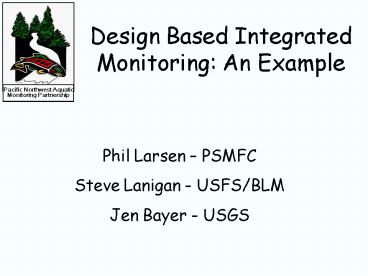Design Based Integrated Monitoring: An Example - PowerPoint PPT Presentation
1 / 22
Title:
Design Based Integrated Monitoring: An Example
Description:
Some are design based/some are not. ... Who houses and maintains? Utilize existing regional entities (PNW RGIC) to facilitate this task. ... – PowerPoint PPT presentation
Number of Views:63
Avg rating:3.0/5.0
Title: Design Based Integrated Monitoring: An Example
1
Design Based Integrated Monitoring An Example
- Phil Larsen PSMFC
- Steve Lanigan - USFS/BLM
- Jen Bayer - USGS
2
Rationale
- Agency specific, generally independent,
monitoring programs currently exist. - Some are design based/some are not.
- Indicators and protocols are not standardized,
even for the same attribute. - Data sharing is difficult.
- GIS layers are not coherent, standardized, nor
complete.
3
Goal
- Implement a case study that shows, for habitat,
fish, and water quality monitoring - How a design-based Integrated Monitoring Program
(IMP) might function - its advantages and disadvantages and
- the many steps involved.
4
Agency A Question
stream habitat
Agency B Question
5
Why a case example?
- Illustrate what a design-based integrated
monitoring program might look like. - Address numerous practical questions that arise
when carrying out an integrated monitoring plan. - Provide a mechanism for continued communication
among existing and potential participants to work
out endless details.
6
Context
- What do we mean by design-based integrated
monitoring? - Monitoring sites are tied to a common statistical
design to - Facilitate data sharing
- Prevent unnecessary/redundant data collection
- Facilitate coordinated monitoring
- Facilitate use of common protocols for common
indicators
7
Context
- What do we mean by design based integrated
monitoring? - Common protocols are used for common indicators
- Ease of data sharing
- Common availability of GIS coverages
8
Context
- Many agencies are monitoring (or planning to
monitor) stream/watershed condition in Lower
Columbia ESU using similar attributes and
similar/same protocols - Policy driven questions/objectives
- Listing decisions
- Population estimates
- Biological integrity
- Habitat and WQ conditions
- Watershed conditions
9
Context
- Can we use this two-state ESU as a case example
to work out the mechanics of setting up a design
based integrated monitoring program?
10
Primary Objective
- To the extent possible, apply the concept of a
master sample as the basis of site selection to
drive an integrated monitoring program.
11
Potential Participants
NOAA USFWS TRIBES LCFRB Watershed
Councils LCREP USGS
- ODFW
- OR DEQ
- WDFW
- WDOE
- AREMP
- PIBO
- ACOE
12
Elements of IMP Master Sample
- Select master sample
- 1100 K stream network is available for entire
Lower Columbia ESU - 124 K stream network is available for WA Lower
Columbia ESU - Is 124 K stream network needed for OR?
- Manage/distribute master sample
- Who? How?
13
Elements of IMP Existing andFuture Monitoring
- Existing monitoring?
- Who is monitoring what where?
- What are the questions addressed by the
monitoring? - Future monitoring plans (five year time frame)
- Who?
- What are the questions?
14
Elements of IMP Resources
- Who compiles the case study?
- CSMEP, CBFWA, and OR Plan may have some resources
- Potential future sources to implement
- Agencies contribute for the good of the cause
- NPCC/BPA
- NOAA
- State agency salmon recovery funds
- OWEB
15
Elements of IMP Indicator selection
- Indicators
- Habitat standard set across agencies
- add agency specific as needed
- Biological
- Fish
- Macroinverts
- Water Chemistry/temperature
16
Elements of IMP Data Management
- Database management
- Design files
- Protocol catalogue
- Data files build on existing development of
portals - Data sharing agreements
- Utilize existing regional entities (NED) to
facilitate this task.
17
Elements of IMP Field Implementation
- Each agency samples its assigned sites.
- Develop a core team funded across agencies to
visit a base set of sites for key attributes. - need same/comparable protocols
18
Elements of IMP GIS coverages
- Make available a core set of GIS coverages
(layers) that all in study area would have access
to and agree on. - Road density
- Land use/cover
- Geology
- Restoration projects
- etc.
- Who houses and maintains?
- Utilize existing regional entities (PNW RGIC) to
facilitate this task.
19
Elements of IMP Reporting
- What reports should be anticipated?
- How do we decide when the case study is
completed? - How to evaluate and move on from case study?
20
Whats in it for me?
- Saves me some money allows me to use others
data easily - Allows my data to be used for regional estimates
(i.e., the greater good) - Able to detect trends more quickly (and take
corrective action)
21
Whats in it for me?
- Allows me to determine how Im doing relative to
others - Whats my share of the responsibility for the
current condition (good/bad)? - Whats my resource look like compared with
others? - Lets public know how we are all doing
22
Whats in it for me?
vs
Agency pays 100 of the cost to sample 10 sites
Agency pays 15 of the total cost and gets data
for 150 sites
Agency cost is the same for either scenario































